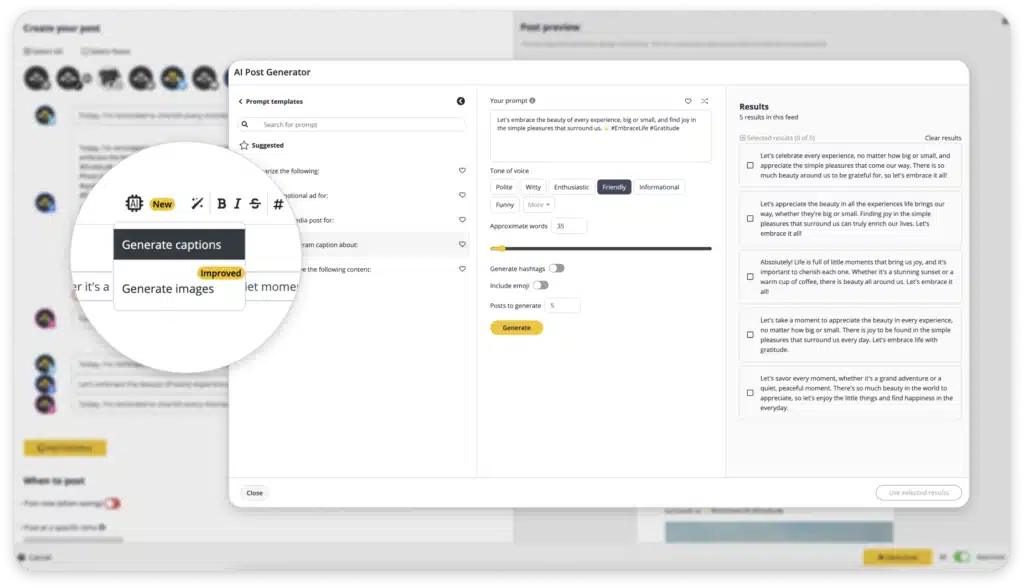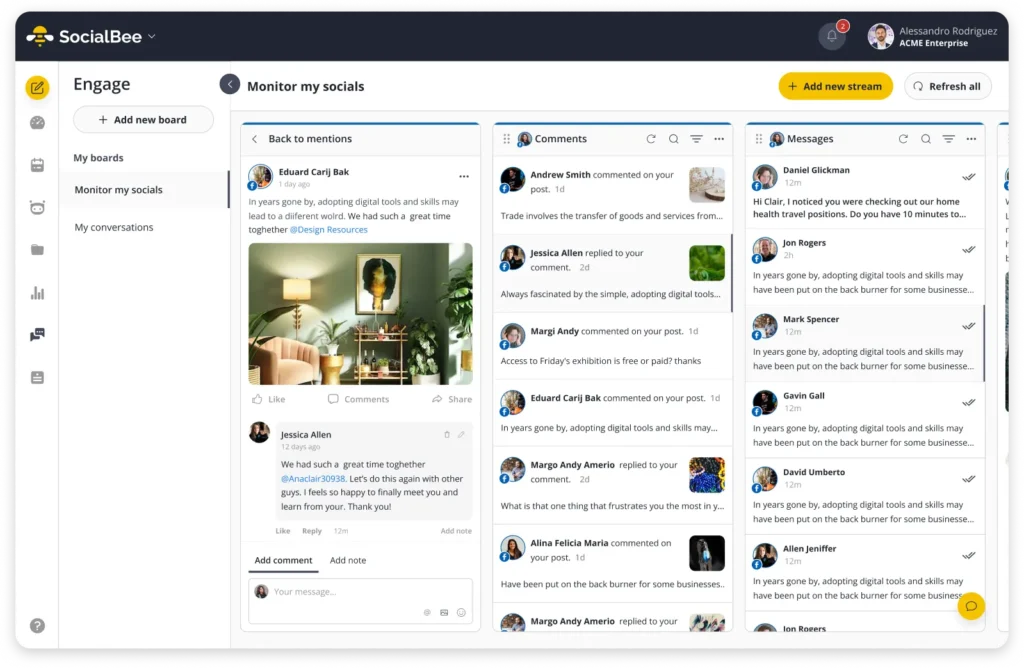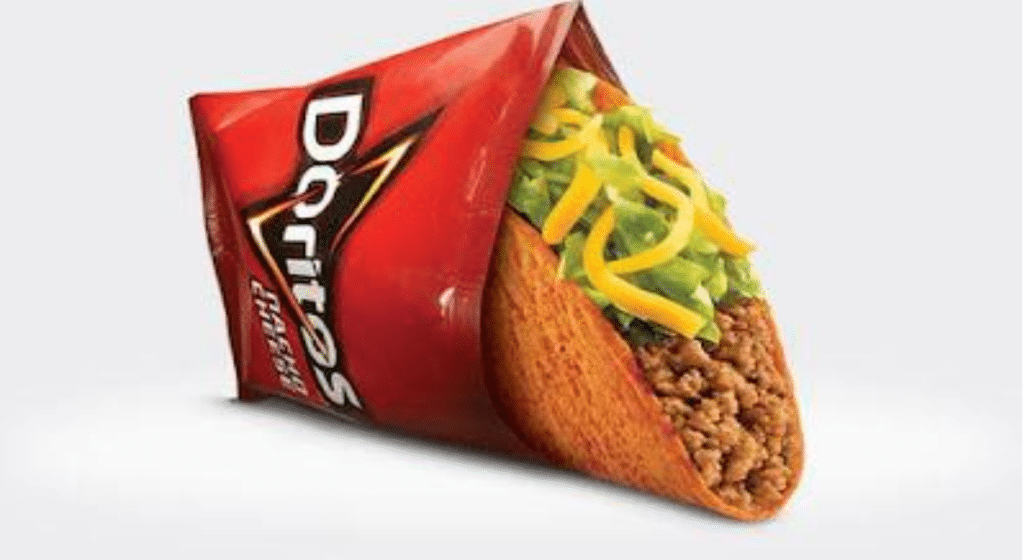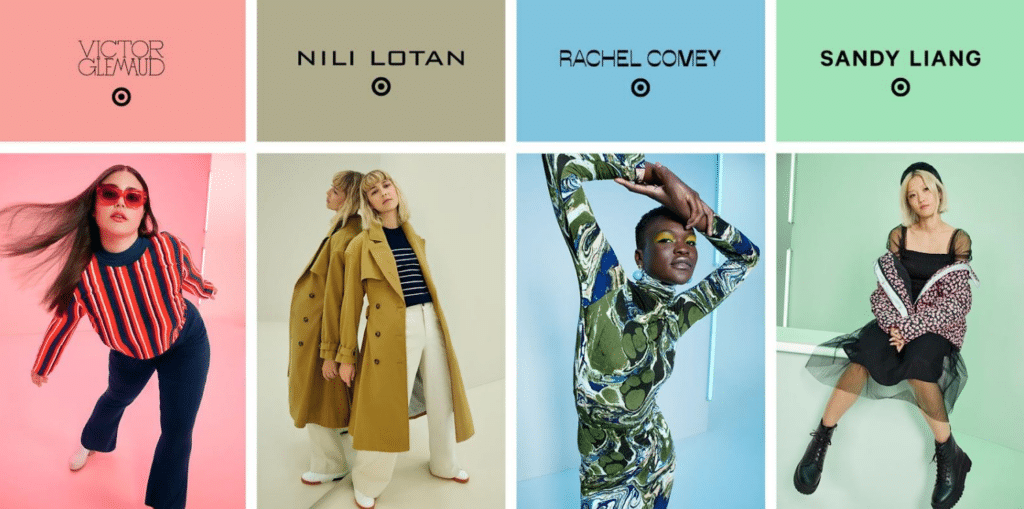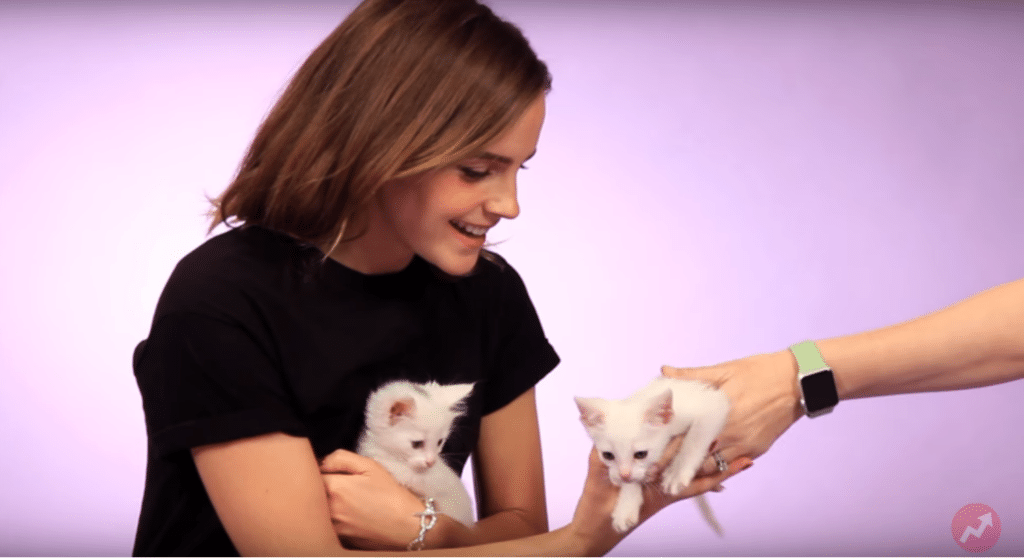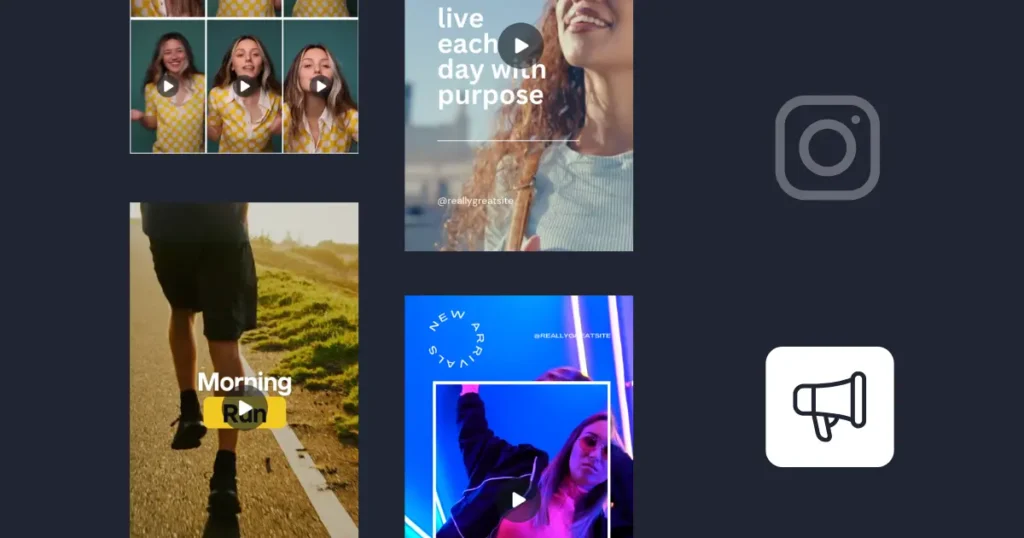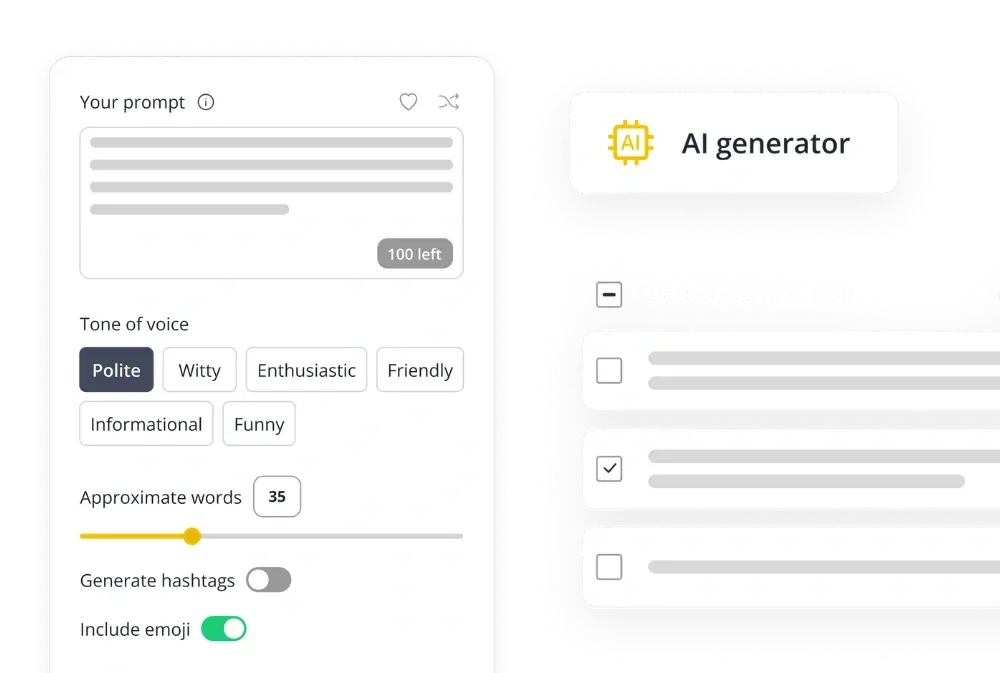
Guest Author
In one of the most memorable co-branding moments of the decade, a man donned in a spacesuit took a daring leap from a space pod, capturing his breathtaking descent with a GoPro in hand. Not only did this viral sensation break three world records, but it also underscored the sheer power and potential of strategic brand collaborations.
The real winners behind this sky-high co-branding venture were RedBull and GoPro’s sales. RedBull’s sales grew by 7% in the next six months, and GoPro generated $32.26 million by the end of the year—that’s the power of co-branding.
In this article, we’ll unpack the magic behind such successful endeavors and present four proven strategies to elevate your business through brand partnerships, while shedding light on some examples of co-branding. Ready to make the most of inter-brand cooperations?
We’re SocialBee LABS SRL, part of WebPros. We use the information you provide to share relevant content and product updates, as outlined in our Privacy Policy. You can opt out anytime.
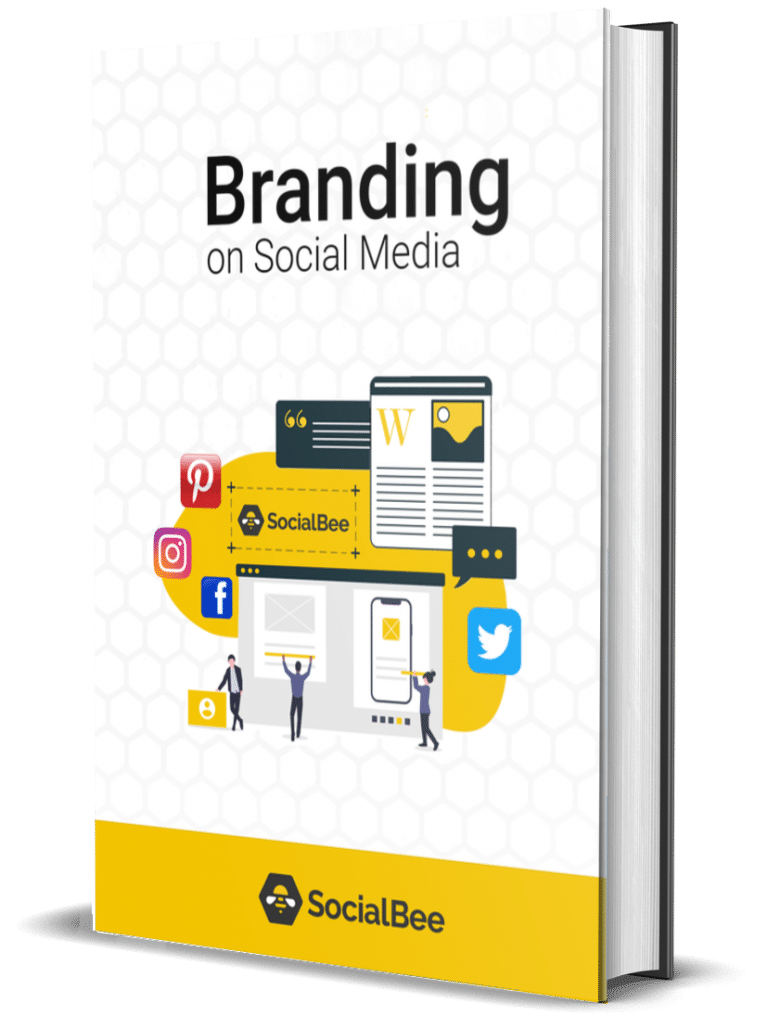
Short Summary
- Co-branding is a strategic marketing partnership where two or more brands collaborate to introduce a unique product or service, leading to increased customer loyalty, expanded reach, and higher sales.
- There are two main types of co-branding: Ingredient co-branding, where one brand becomes a crucial component of another, and Composite co-branding, where multiple brands with distinct products or services create something entirely new.
- Engaging in a co-branding partnership offers benefits such as expanding reach and audience, leveraging combined resources, innovating product offerings, or boosting brand credibility.
- Four successful co-branding strategies include product co-branding, influencer co-branding, content co-branding, and innovation co-branding, each with its own unique approach to collaboration and customer engagement.
- Examples of successful co-branding partnerships include Nike and Spotify’s product co-branding, Target’s influencer co-branding with fashion designers, and BuzzFeed’s content co-branding with Best Friends Animal Society, illustrating the diverse ways co-branding can benefit businesses.
What Is Co-Branding?
Co-branding is a strategic marketing partnership where two or more brand names come together, forging a brand partnership to introduce a unique product or service.
This co-marketing technique doesn’t just create a buzz; it can dramatically enhance customer loyalty, extend your brand’s reach, and exponentially amplify sales and revenue.
Co-branding can be viewed as a synergy, where the combined strength of two brands can lead to outcomes neither could achieve on their own.
The initiative provides an expanded audience, a collective pool of resources, staff, and budget, all orchestrated under meticulous brand management. There are various ways this collaborative effort can manifest, ranging from co-developed products to joint marketing campaigns.
The two main types of co-branding are:
- Ingredient co-branding
- Composite co-branding
1. Ingredient Co-branding
This is about the confluence of brands where one becomes an essential component or ‘ingredient’ of another. A classic example of this strategy in action is the association between Intel and HP.
While Intel, a brand synonymous with high-performance microprocessors, is the ‘ingredient’, HP, a giant in computer technology, integrates it to enhance its product’s value proposition.
2. Composite Co-branding
This is where the collaboration reaches its zenith. Two or more brands, each with its own distinct product or service, come together to craft something entirely new.
An illustration of this would be the alliance between banks and airline companies. When they come together, what emerges is an airline credit card, offering consumers the dual benefits of financial transactions and travel perks.
Why Should I Engage in a Co-Branding Partnership?
Engaging in a co-branding partnership can offer a multitude of benefits for businesses, both established and emerging.
Here’s a rundown of the compelling reasons to consider such a collaboration:
- Expand reach and audience: By partnering with another brand, you tap into their customer base, expanding your potential audience without the high costs of traditional customer acquisition methods.
- Leverage combined resources: Pooling resources, whether it’s financial, technological, or creative, can lead to more effective marketing campaigns and product developments.
- Innovate product offerings: Combining the expertise of two brands can lead to the creation of unique products or services that wouldn’t have been possible individually.
- Gain competitive advantage: A successful multiple sponsor co-branding partnership can set you apart from competitors, offering consumers something unique that others can’t replicate.
- Strengthen brand positioning: If one of your brand’s business objectives is to reposition itself in the market or shift its image, a strategic co-branding partnership can aid in reinforcing that change.
4 Successful Co-Branding Strategies
81% of customers need to trust a brand to consider buying from it, and co-branding is a great way to give your target audience the assurance and brand credibility they require. It can put your business on the map and open you up to new users who had no idea your brand existed.
But all your efforts will reap impeccable results only when you choose the right co-branding strategy.
Here are the top four such strategies that can skyrocket your business success:
- Content co-branding
- Product co-branding
- Influencer co-branding
- Innovation co-branding
1. Content Co-Branding
Co-branding content is an effective way to create mutually beneficial assets (content) to boost awareness, increase perceived value, and build engagement. It can be anything from co-branded ebooks to podcasts and blog posts.
Usually, co-branded content ventures are shared behind a lead generation form. The leads generated from the content are tracked with UTM codes and shared between all the partners.
However, not every content format is right for every collaboration. Ideally, you should produce several content forms, allowing your audience to consume it how they see fit.
Here are the best content types for co-branding:
- Social media content
- Long-form content
- Podcasts
- Webinars
A. Social Media Content
Social media has undeniably transformed the way brands interact with their audience, offering a direct line of communication and a platform for showcasing brand identity. When it comes to co-branding efforts, leveraging social media content can be a game-changer.
From image posts to videos, stories, or reels, social media platforms offer an array of formats. This allows co-branded campaigns to be diverse, catering to different segments of the audience and keeping the content fresh and engaging.
Social Media Co-Branding Campaign Tips
Each brand brings its own flair, expertise, and audience. When combined effectively, co-branding can catapult a campaign’s reach and impact to new heights.
The following are actionable tips to make sure your co-branded campaign thrives on social media:
- Diversify your content format
- Leverage AI for personalization
- Create platform-specific content
- Engage promptly with your audiences
Tip #1: Diversify Your Content Format
Different audience segments interact with various content types. While some users engage more with videos, others might prefer images or polls. For co-branded campaigns, combining each brand’s strengths through multiple formats can ensure broader engagement.
By fusing the signature content style of each brand—like one brand’s impactful visuals with another’s engaging storytelling—co-brands can offer unique content that stands out.
Tip #2: Leverage AI for Personalization
Personalized content tends to resonate better. AI can identify cross-over points between the two brands’ audiences, ensuring that the content caters to shared interests, leading to higher engagement rates.
PRO TIP: With AI tools like SocialBee, brands can tailor posts based on user preferences and behaviors. All you have to do is craft a prompt providing our AI with all the essential details about your audience, brand personality, and content goals, and your campaign content will be ready in seconds. |
Tip #3: Create Platform-Specific Content
Each social platform attracts a specific user demographic with unique behaviors. Tailored content ensures optimal engagement on each platform.
A joint strategy can help tap into both brands’ followers bases effectively. For example, if one brand has a strong LinkedIn presence and the other excels on Instagram, they can craft platform-specific content that leverages both strengths.
Tip #4: Engage Promptly with Your Audiences
Real-time engagement builds brand loyalty and fosters a sense of community.
Addressing audience interactions promptly, especially queries about the collaboration, can further solidify the authenticity of the partnership and showcase a united front.
PRO TIP: Interact and engage with comments or mentions from your audience across multiple channels directly via SocialBee, fostering quicker response times and enhancing the overall customer experience. |
Types of Co-Branding Content on Social Media
Looking for content inspiration for your next collaboration?
Here are five social media post ideas you can use in co-branding campaigns:
- Joint Product Announcements: Remember the magic when Spotify and Starbucks teamed up? They created playlists available in Starbucks stores, and the announcement was beautifully portrayed on social media, blending the vibes of coffee and music.
- Interactive Polls & Quizzes: Brands can co-create quizzes or polls, making audiences interact and choose between products or services. Imagine a fun poll by Ben & Jerry’s and Netflix about which ice cream flavor pairs best with binge-watching!
- Co-Branded Tutorials: Imagine a beauty brand and a skincare brand teaming up. They could release a video tutorial on how to get a perfect glow using both their products, emphasizing the combined benefit.
- Testimonials & Reviews: Real users sharing their experiences using co-branded products. Picture a video of a travel blogger detailing their journey using both Airbnb and Lonely Planet.
- Collaborative Challenges & Giveaways: Engage users by hosting a challenge or giveaway, like a dance challenge for a music app and sportswear brand collaboration. Winners could get exclusive merchandise from both!
B. Long-Form Content
Long-form content offers an in-depth exploration of topics, enabling brands to showcase their expertise, tell compelling stories, and engage their audience at a more profound level. When two or more brands come together to co-create such content, the result can be both insightful and expansive.
Typically, long-form content includes eBooks, white papers, blog posts, and reports. Every partner can share their own expertise and target a broader audience.
C. Podcasts
Podcast episodes allow one or more expert speakers to share their knowledge in a fun, casual way. You can even record the podcast and create branded videos and audio content from the same conversation.
This can make the content shareable across multiple platforms—social media, emails, DMs, and more.
D. Webinars
Webinars stand as a powerful medium for real-time interaction and live engagement. They offer a space where experts from various fields can come together, share insights, and foster a dynamic conversation with the audience. A noteworthy mention in this context is SocialBee. They’ve embraced the approach of collaborating with experts from diverse fields.
The benefit is two-fold: audiences receive a broader spectrum of insights, and the recorded sessions can be shared across platforms for extended reach. If you’re curious about how brands are leveraging such collaborations, a visit to SocialBee’s Webinars might offer some insights.
Expert Tip: When creating co-branded content, always leave room for content marketing partners to customize the asset to fit their voice.
2. Product Co-Branding
A successful product co-branding partnership capitalizes on all the partners’ strengths to create a one-of-a-kind product. It could be in terms of designs, customer experience, technology, or any other aspect that can set the brands apart.
Think of the Doritos Locos Taco, the famous collaboration between Frito-Lay and Taco Bell. The partnership was a blast, with Taco Bell selling above 1 billion units of the co-branded product within the first year alone.
So, choose the right partner and work with them to design a co-branded product or service that is unique, appealing, and useful for customers. Outline the product’s marketing and social media strategy—launch plans, timelines, channels, etc.
Prioritize brands that have already shown promising results with past partnerships. Before co-branding, set clear expectations about manufacturing, promotion, inventory size, content, and revenue shares.
3. Influencer Co-Branding
In influencer co-branding, you partner with an influencer to create a product while incorporating the knowledge of both parties. For example, if you are a beauty brand, you can partner with an influencer to create a product line that uses your beauty expertise and the influencer’s unique style—similar to Jenn IM’s ColourPop cosmetic line.
In most cases, influencer co-branding isn’t just a product development plan but also a marketing strategy. A co-branded product line with an ideal influencer should create a halo effect, thus generating a new customer base, increasing brand awareness, and even upselling and cross-selling.
Here are the factors you need to consider before picking an influencer to partner with:
- Your brand’s messaging meshes well with the influencer’s image.
- The influencer doesn’t already have another product for sale that competes with your existing line of products.
- The influencer has a large enough audience to promote the co-branded product (look for engagement metrics and ask for verifiable data, like the size of their email list, organic reach, average web visitors, etc.).
4. Innovation Co-Branding
The collaborative nature of co-branding is an excellent place for innovation and creativity to take the center seat.
Take the Gucci and Roblox partnership product, for example. The brands, together, created a virtual Gucci Garden on Roblox where users can explore Gucci’s latest collection and buy virtual items. The brands even hosted giveaways, allowing selected winners to receive real-world Gucci products.
Innovative co-branding is most popular in tech-focused brands, especially in the gaming space. But, digital tool and service-providing companies also often produce innovative co-branded products.
So, if you are planning to create a digital product or asset, co-branding for innovation might be the way to go. To further promote the campaigns, you can use giveaway tools to create and host gifts for selected participants.
However, creating such a product will require significant research and development. Thus, only choose brands ready to experiment and create truly innovative products.
3 Co-Branding Examples to Look Into
When done right, this fusion can catapult products and services into market standouts.
Here are three compelling examples that beautifully illustrate its potential and the innovative ways in which brands can come together:
- Nike x Spotify
- Victor Glemaud, Nili Lotan, Rachel Comey, and Sandy Liang x Target
- BuzzFeed x Best Friends Animal Society (BFAS)
1. Nike x Spotify: Product and Innovation Co-Branding
The best co-branding partners don’t always need the same market to make beautiful music together, like the Nike and Spotify team up.
Nike and Spotify partnered to create the Nike+ Running application to enhance the runners’ overall in-run music experience.
The Nike Pace Station allowed users to access Spotify through its apps, enabling them to access a slew of Nike-curated playlists without an unnecessary app change. Plus, the partnership introduced a free personalized 100-song playlist to push the runners to their desired pace.
The result—the unlikely collaboration improved user experience and also gave both target audiences an added incentive to choose the partnering brand over the competitor.
2. Victor Glemaud, Nili Lotan, Rachel Comey, and Sandy Liang x Target : Influencer Co-Branding
Target is mostly known for its budget-friendly products, but with this high-fashion co-branding campaign, Target introduced a line of designer merchandise in its stores.
Partnering with top fashion designers Victor Glenmaud, Nili Lotan, Rachel Comey, and Sandy Liang, Target brought in The Fall Designer Collection. The collection included over 180 apparel and accessories, representing each designer’s signature aesthetics.
The co-branding with top industry names solidified Target’s fashion credibility. The Target collaboration also made the participating designers (influencers) a household name—a win-win for both.
3. BuzzFeed x Best Friends Animal Society (BFAS): Content Co-Branding
Co-branding doesn’t always have to revolve around a new product. It can also yield content that inspires the audience to take desired action, and that’s what BuzzFeed and Best Friend Animal Society’s co-branded video featuring Emma Watson is also about.
For this collaboration, the BFAS team wanted to leverage BuzzFeed’s 200 million readership. They set up an interview with Emma Watson where she answered questions while playing with kittens. The subsequent article published after the interview was exactly what a fan would assume: Emma answering fans’ questions all while surrounded by cute kittens.
The co-branded article ended with a call-to-action (CTA), advertising that all the kittens featured in the video are ready for adoption—a clever use of content co-branding.
Frequently Asked Questions
Choosing the right co-branding partner is crucial for the success of a collaborative venture. Initially, it’s vital to align on core values, ensuring both brands resonate harmoniously with the target audience.
Equally important is assessing market position; partnering with a brand of comparable stature can lead to a balanced collaboration. Practical considerations, such as a potential partner’s financial stability and past partnerships, offer insights into their reliability and approach.
Before finalizing any partnership, clear communication about roles, expectations, and contributions is imperative, laying the groundwork for a successful and synergistic co-branding experience.
When co-branding, here’s how to ensure data privacy and security:
- Set clear data-sharing agreements.
- Limit the amount of data shared and use secure methods (encryption and anonymization).
- Use the TCPA compliance checklist.
- Choose a partner with a good data privacy and security track record.
- Conduct regular security audits throughout the partnership.
While co-branding can be an extremely fruitful venture, collaborating brands also share risks like financial losses, diluted brand identity and equity, creating conflicts, and losing control.
These pitfalls can be unavoidable when partnering brands have different or conflicting messages and unclear go-to-market value propositions. In some cases, co-branding can also create competition, thus cannibalizing the brands’ own products and co-branded products.
Ready to Integrate a Brand Partnership in Your Marketing Strategy?
Co-branding is a powerful strategy to boost your brand awareness and drive skyrocketing profits. While there can be a few hiccups, brands can easily overcome them by negotiating every critical aspect of the collaboration beforehand.
Now, start reaching out to other brands and brainstorm your own co-branding collaboration idea. Leverage social media to make your venture even more successful. Using SocialBee to create, schedule, publish, and analyze all your co-branding social media needs in one place. Ready? Sign up for a 14-day free trial now!

Schedule Your Co-Branded Content with SocialBee!
About the author: A seasoned writer and storyteller, Sara does her best to share her experience with the world and help brands and entrepreneurs find their voice. She loves the learning curve that comes with writing, so she gladly takes on new topics that will expand her own knowledge and expertise. The only thing Sara steers clear of? Anything resembling a comfort zone in life, as well as writing.

